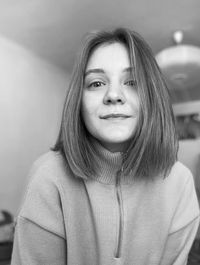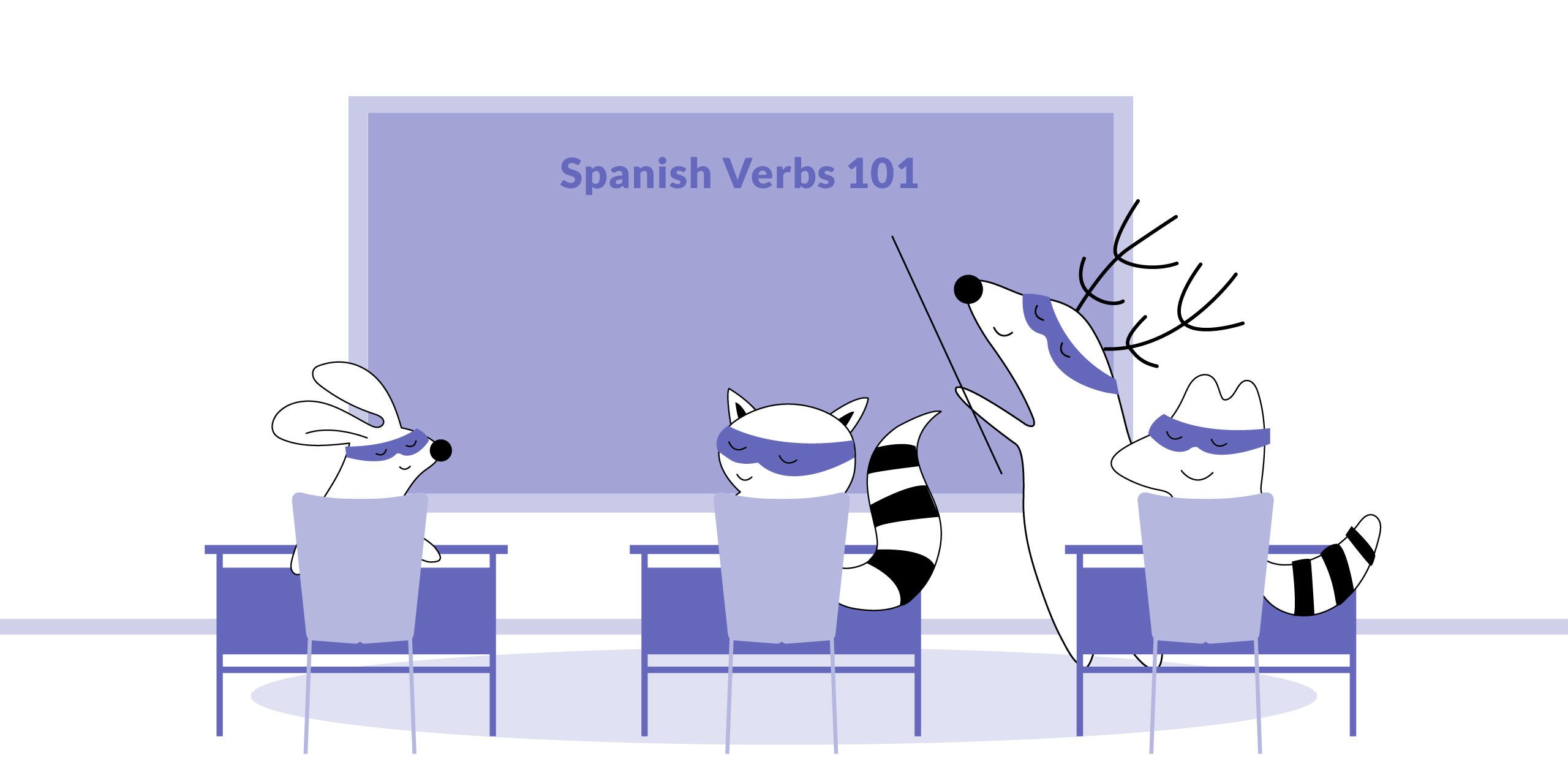
When it comes to learning a new language, verbs will undoubtedly be one of the most important aspects of the process. After all, verbs are what help us to express actions and states of being. Spanish has many different verb forms and tenses, which can initially seem daunting. However, with a little practice, you'll be conjugating verbs like a pro!
In this article, we will explore the most common Spanish verbs in greater detail. We'll cover the basics – present tense, past tense, future tense, and more! By the end of this article, you'll have a better understanding of how to use Spanish verbs correctly. Read on, and boost your language skills!
Regular Verbs vs. Irregular Verbs
When it comes to learning Spanish verbs, one of the first things you'll need to understand is the difference between regular and irregular verbs. As their names suggest, regular verbs follow set patterns when conjugated, while irregular verbs do not.
Most verbs in Spanish are classified as regular verbs. This means that they follow a set conjugation pattern when conjugated into different tenses.
For example, the regular verb cantar (to sing) would be conjugated as follows:
| yo | canto |
| tú | cantas |
| él/ella/usted | canta |
| nosotros | cantamos |
| ellos/ellas/ustedes | cantan |
| yo | canto |
| tú | cantas |
| él/ella/usted | canta |
| nosotros | cantamos |
| ellos/ellas/ustedes | cantan |
Here is an example in the sentence:
Spanish
English
Yo canto una canción.
I sing a song.
As you can see, to conjugate a regular verb in the present tense, all you need to do is remove the ending (-ar, -er, or -ir) and add the appropriate ending for each subject pronoun.
Irregular verbs, on the other hand, do not follow this set pattern. This means that they must be memorized separately. While there are only a few hundred irregular verbs in Spanish, they are some of the most commonly used verbs in the language.
Some of the most common irregular Spanish verbs include ser (to be), ir (to go), dar (to give), hacer (to do/make), and tener (to have).
Here is the conjugation for the irregular verb ser in the present tense:
| yo | soy |
| tú | eres |
| él/ella/usted | es |
| nosotros | somos |
| ellos/ellas/ustedes | son |
| yo | soy |
| tú | eres |
| él/ella/usted | es |
| nosotros | somos |
| ellos/ellas/ustedes | son |
Example:
Spanish
English
Ella es una estudiante.
She is a student.
And here’s how to conjugate the irregular verb hacer in the present tense:
| yo | hago |
| tú | haces |
| él/ella/usted | hace |
| nosotros | hacemos |
| ellos/ellas/ustedes | hacen |
| yo | hago |
| tú | haces |
| él/ella/usted | hace |
| nosotros | hacemos |
| ellos/ellas/ustedes | hacen |
Example:
Spanish
English
Él hace la cama.
He makes the bed.
As you can see, these most common Spanish verbs do not follow the regular conjugation pattern. This is why it's important to memorize the conjugation for each irregular verb separately.

What Is an Auxiliary Verb?
Before we get into conjugating verbs in different tenses, there's one more concept you need to be familiar with – auxiliary verbs.
An auxiliary verb is a verb that is used along with a main verb to express different tenses or states of being. In Spanish, the most common auxiliary verbs are ser and estar – verbs “to be” in Spanish, both irregular.
The verb ser is used to express permanent or essential qualities, while estar is used to describe temporary conditions. For example:
| La mesa es negra. | The table is black. | This is a permanent quality. |
| Estoy enfermo. | I am sick. | This is a temporary condition. |
| La mesa es negra. | The table is black. | This is a permanent quality. |
| Estoy enfermo. | I am sick. | This is a temporary condition. |
As you already know how to conjugate ser, let’s have a look at the conjugation of the verb estar in the present tense:
| yo | estoy |
| tú | estás |
| él/ella/usted | está |
| nosotros | estamos |
| ellos/ellas/ustedes | están |
| yo | estoy |
| tú | estás |
| él/ella/usted | está |
| nosotros | estamos |
| ellos/ellas/ustedes | están |
So, now that we've covered the basics of auxiliary verbs, let's move on to conjugating verbs in different tenses.
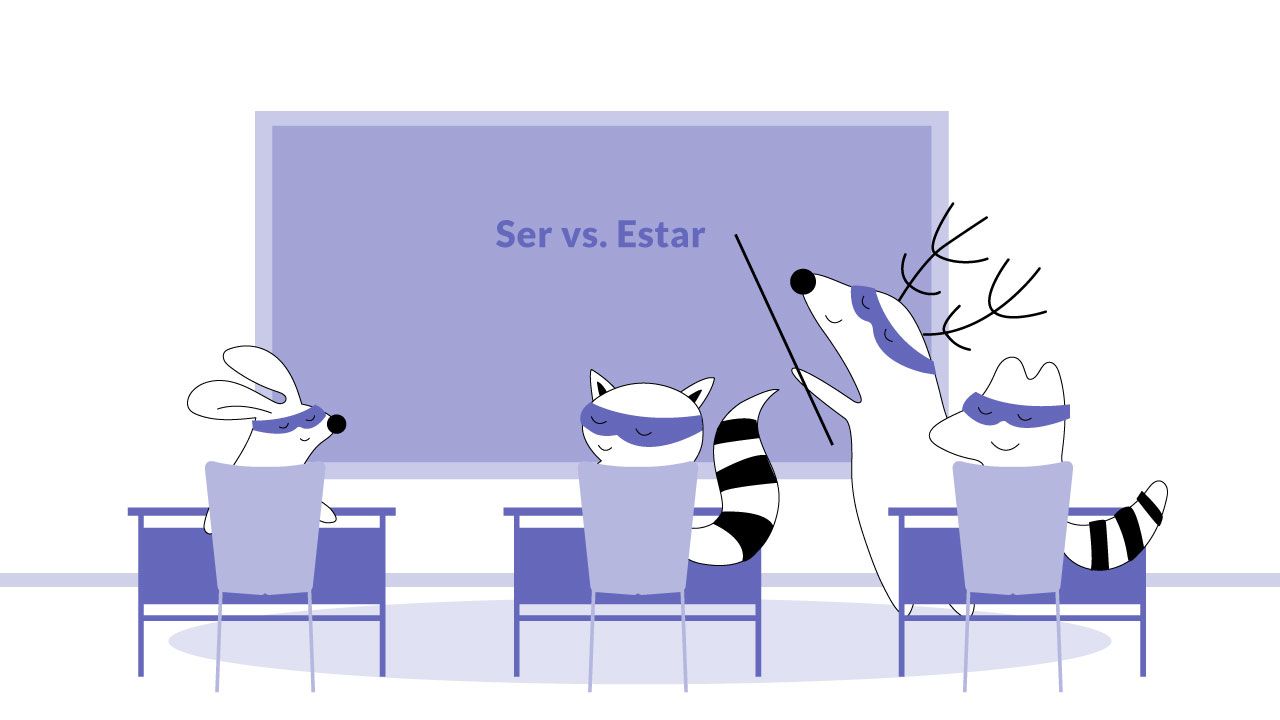
Spanish Verb Tenses
There are many different Spanish verb tenses, and each one expresses a different meaning. In this section, we'll cover some of the most common Spanish verb tenses and when to use them.
Present Tense
The present tense is used to express actions that are happening right now or actions that happen regularly.
For regular verbs, the present tense is conjugated by removing the ending (-ar, -er, or -ir) and adding the appropriate ending for each subject pronoun.
For irregular verbs, the present tense must be memorized separately.
We've provided a few examples of conjugation for both regular and irregular verbs above. Here are some more examples of the present tense in action:
Spanish
English
Yo como una manzana.
I am eating an apple.
Tú lees un libro.
You are reading a book.
Él bebe agua.
He is drinking water.
Past Tense
The past tense is used to describe actions that have already happened. However, there are two different types of past tense in the Spanish language – the preterite and the imperfect.
The preterite describes actions that took place and were completed at some specific time in the past.
The imperfect, on the other hand, is used to describe either unfinished or ongoing actions in the past or to talk about past habits.
Here are some examples of the preterite and imperfect tenses in action:
| Past Tense | Example | Translation |
|---|---|---|
| Preterite | Yo comí una manzana. | I ate an apple. |
| Imperfect | Yo comía una manzana. | I was eating an apple. |
| Preterite | Tú leíste un libro. | You read a book. |
| Imperfect | Yo solía leer un libro. | I used to read a book. |
| Preterite | Él bebió agua. | He drank water. |
| Imperfect | Él bebía agua. | He was drinking water. |
| Past Tense | Example | Translation |
|---|---|---|
| Preterite | Yo comí una manzana. | I ate an apple. |
| Imperfect | Yo comía una manzana. | I was eating an apple. |
| Preterite | Tú leíste un libro. | You read a book. |
| Imperfect | Yo solía leer un libro. | I used to read a book. |
| Preterite | Él bebió agua. | He drank water. |
| Imperfect | Él bebía agua. | He was drinking water. |
As you can see, the preterite is conjugated using the -ar, -er, or -ir ending, while the imperfect is conjugated using the -aba, -ía, or -ía ending.
Here is an example of irregular past tense conjugations (for the preterite) with the familiar verb hacer:
| yo | hice |
| tú | hiciste |
| él/ella/usted | hizo |
| nosotros | hicimos |
| ellos/ellas/ustedes | hicieron |
| yo | hice |
| tú | hiciste |
| él/ella/usted | hizo |
| nosotros | hicimos |
| ellos/ellas/ustedes | hicieron |
For example:
Spanish
English
Él hizo la cama.
He made the bed.
It's important to choose the right tense when speaking or writing in Spanish, as using the wrong tense can change the meaning of what you're trying to say.
Future Tense
The future tense is used to describe actions that will happen at some point in the future.
To form the future tense of regular -ar, -er, and -ir verbs, add the following endings to the infinitive of the verb: -é, -ás, -á, -emos, -éis, -án.
For example, the regular verb cantar would be conjugated as follows:
| yo | cantaré |
| tú | cantarás |
| él/ella/usted | cantará |
| nosotros | cantaremos |
| ellos/ellas/ustedes | cantarán |
| yo | cantaré |
| tú | cantarás |
| él/ella/usted | cantará |
| nosotros | cantaremos |
| ellos/ellas/ustedes | cantarán |
Example:
Spanish
English
Nosotros cantaremos una canción.
We will sing a song.
When it comes to irregular verbs in the future tense, they must be memorized, as there is no set rule for conjugation. However, many irregular verbs in the future tense are formed by taking the regular verb stem and adding the appropriate ending.
For example, the irregular verb hacer is conjugated as follows in the future tense:
| yo | haré |
| tú | harás |
| él/ella/usted | hará |
| nosotros | haremos |
| ellos/ellas/ustedes | harán |
| yo | haré |
| tú | harás |
| él/ella/usted | hará |
| nosotros | haremos |
| ellos/ellas/ustedes | harán |
Example:
Spanish
English
Haré mi tarea.
I will do my homework.
As you can see, the future tense is a handy way to describe what you're going to do in the future. Whether you're making plans with friends or talking about your goals, the future tense is sure to come in handy!
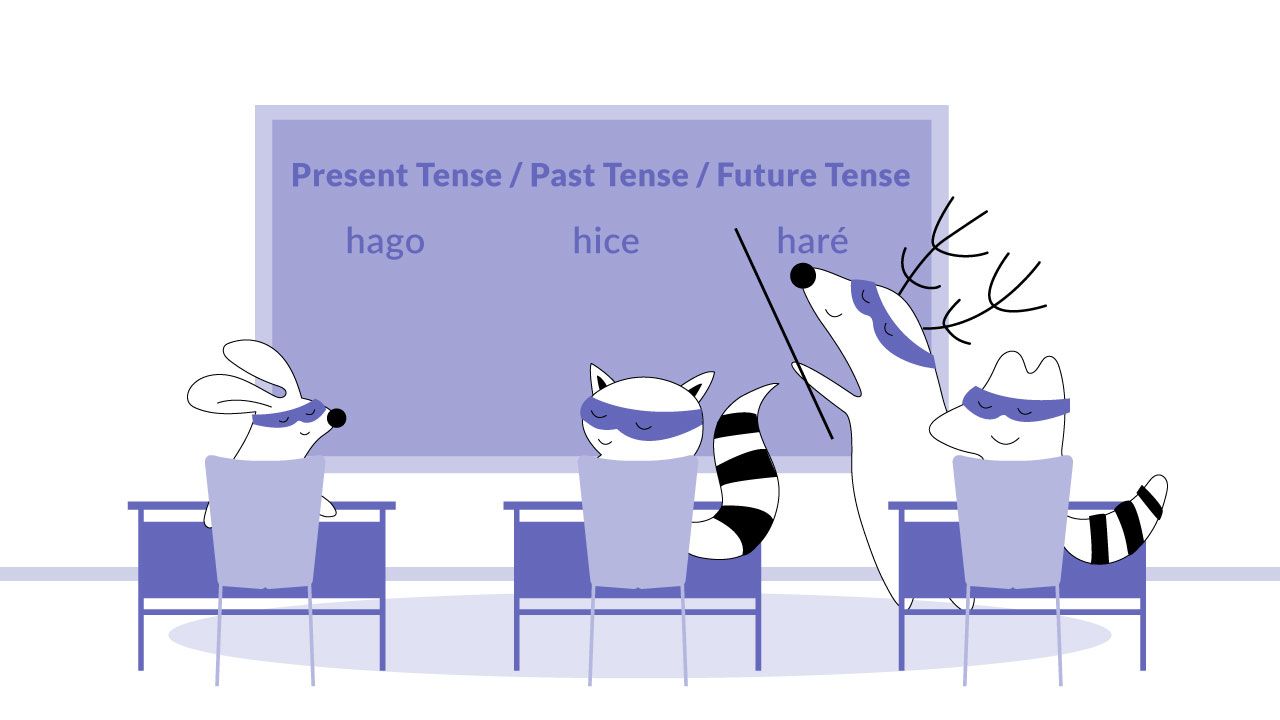
Moods
In addition to the different verb tenses, there are also different moods in Spanish. The mood of a verb indicates the attitude or feeling of the speaker. The three main moods in Spanish are indicative, subjunctive, and imperative, with each mood having its own set of conjugations.
Indicative Mood
The indicative mood is by far the most common mood in Spanish. It is used to describe actions or states of being that are considered to be factual or real. The indicative mood is used for statements of fact, opinion, or belief.
For example:
Spanish
English
Yo soy un estudiante.
I am a student.
Tú eres rápido.
You are fast.
Él es lento.
He is slow.
Subjunctive Mood
The subjunctive mood is used to express doubt, uncertainty, or desire. It can also be used to express emotions such as hope, fear, or anger. The subjunctive mood is often used in subordinate clauses.
Here are a few examples:
Spanish
English
Dudo que tú seas un estudiante.
I doubt that you are a student.
Es posible que yo vaya.
It's possible that I will go.
Me alegro que tú vengas.
I'm glad that you're coming.
Imperative Mood
The imperative mood is used to give commands or make requests. The imperative mood is only used with tu, nosotros, and vosotros forms of the verb.
For example:
Spanish
English
Lavar la ropa.
Do the laundry.
No comer mucho.
Don't eat too much.
Estudiar para el examen.
Study for the exam.
As you can see, there are many different verb tenses and moods in Spanish. It's important to learn as much as possible to communicate effectively in the language.
The Bottom Line
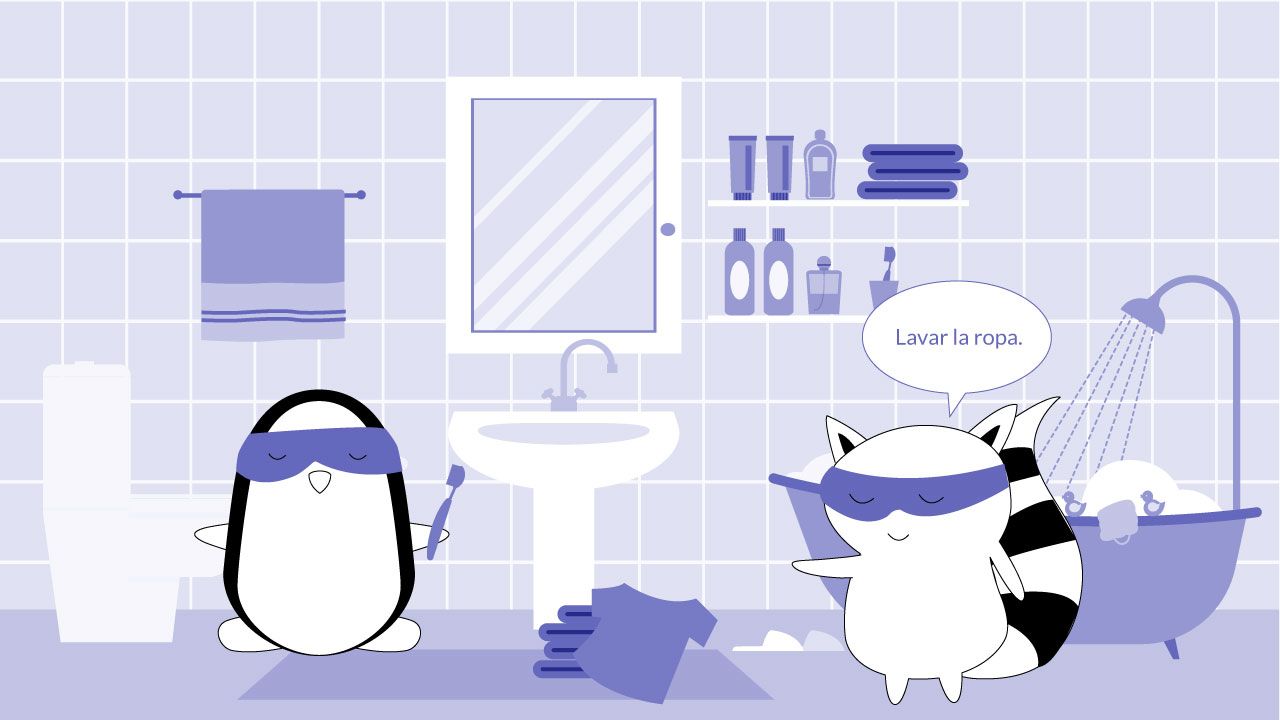
The Spanish verbs list is pretty extensive, and it might seem impossible at first to learn how to conjugate them all. While Spanish verbs can indeed be tricky to master, with a little practice, you'll be conjugating them like a pro!
Now you know the basics of Spanish verb conjugation in the present, past, and future tenses, and more! As you continue learning Spanish, make sure to memorize all of the verb conjugations so that you can communicate effectively in the language.
And, if you want to boost your Spanish vocabulary even further and learn Spanish verbs in a fun way, make sure to download our Langster app and practice this beautiful language through stories. Good luck!

